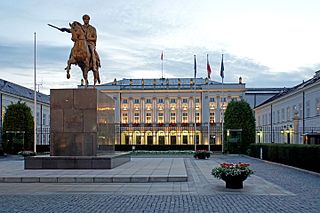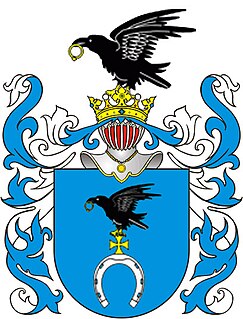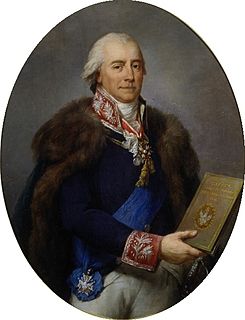
Poraj is a Polish Coat of Arms. Used by several knighthood families of medieval Poland and noble families of the Polish–Lithuanian Commonwealth - those descended in the male-line from the Poraj family and those allowed into the heraldic clan by adoption.

The Presidential Palace is the official residence of the Polish head of state and president alongside the Belweder Palace, located in Warsaw, Poland. Originally constructed in 1643 as an aristocratic mansion, it was rebuilt and remodelled several times over the course of its existence by notable architects. The current neoclassical palace was completed in 1818.

Prince Adam Kazimierz Czartoryski was an influential Polish aristocrat, writer, literary and theater critic, linguist, traveller and statesman. He was a great patron of arts and a candidate for the Polish crown. He was educated in England and after his return to Poland in 1758, he became a member of the Sejm (parliament), Crown General of Podolia and Marshal of General Confederation of Kingdom of Poland.

Count Franciszek Maksymilian Ossoliński was a Polish nobleman, politician, diplomat and a patron of arts.

Prince Michał Hieronim Radziwiłł was a Polish nobleman, politician, diplomat and member of the Polish-Lithuanian Radziwill family. He was a Knight of the Order of the White Eagle and a holder of the Order of the Black Eagle. His paternal great-grandfather was Dominik Mikołaj Radziwiłł.

Count Kazimierz Krasiński (1725–1802) was a Polish noble, politician and patron of art. He was the son of Antoni Krasiński and Barbara Zielińska.

Celestyn Czaplic (1723–1804) of the Kierdeja coat of arms was a Polish–Lithuanian szlachcic, politician, writer and a poet. Remembered for his humorous poetry and impeccable moral character, he was a deputy to numerous Sejms of the Polish–Lithuanian Commonwealth, and a marshal of the Sejm of 1766. He held the offices of podczaszy, podkomorzy, and finally, from 1773, of the Master of the Hunt of the Crown. He was the recipient of the Order of Saint Stanislaus and the Order of the White Eagle.

Stanisław Antoni Szczuka h. Grabie was a Polish noble (szlachcic), talented politician and political writer.

Count Tomasz Adam Ostrowski was a Polish nobleman (szlachcic), politician, spokesman, statesman and Count since 1798.

Count Antoni Jan Ostrowski (1782–1845) was a Polish noble (szlachcic), landowner, political and economic activist, general and publicist.

Antoni Mężydło(listen) is a Polish politician. He was elected to the Sejm on October 21, 2007, receiving 42,052 votes in the 5 Toruń district, running on the Civic Platform list. He is active in the Central European Initiative.

Józef Zabiełło h. Topór of was a nobleman (szlachcic) in the Polish–Lithuanian Commonwealth. Great Łowczy of Lithuanian from 1775, konsyliarz of Permanent Council from 1782, deputy of Samogitia to the Great Sejm and Field Hetman of Lithuania from 1793, he was infamous for his support of the Russian Empire in the last years of the Commonwealth.

Antoni Madaliński (1739–1805) – Polish Lieutenant General, commander of 1st Greater Polish National Cavalry Brigade during Kościuszko Uprising.

Franciszek Antoni Kwilecki (1725–1794) was a Polish nobleman, castelan of Kalisz, marshal of the Crown Tribunal (1766), member of the Bar Confederation (1768–1771), Polish envoy to Berlin (1771–1776), deputy to the Sejms of 1761, 1764 and the Great Sejm (1788–1792), which he opened on behalf of Stanisław Kostka Gadomski. Supporter of the Constitution of the 3rd May to which he was a signatory. Starost of Wschowa.
Andrzej Wyglenda is a former Polish motorcycle speedway rider who has won 1971 Speedway World Pairs Championship and Speedway World Team Cup three times. He was won Individual Polish Champion title four times. Between 1985 and 1989 he was a Member of the Sejm of Poland.

Prince Antoni Paweł Sułkowski, of the Sułkowski family, was a Polish division general and later overall commander of the armed forces of the Duchy of Warsaw.

The Constitution of 3 May 1791 is an 1891 Romantic oil painting on canvas by the Polish artist Jan Matejko. It is a large piece, and one of Matejko's best known. It memorializes the Polish Constitution of 3 May 1791, a milestone in the history of the Polish–Lithuanian Commonwealth and a high point of the Polish Enlightenment.

Count Marcin Kazimierz Kątski of Brochwicz was a Polish nobleman, politician, diplomat, scholar, military commander, General of Artillery of the Crown (1667–1710), the Voivode of Kiev (1684–1702) and Castellan of Kraków (1706–1710).

The Didushyts'ki, or Dzieduszycki was a Ruthenian (Ukrainian) and Polish nobility family which was first recorded in 1400.

Wojciech Baranowski was archbishop of Gniezno and primate of Poland.




















